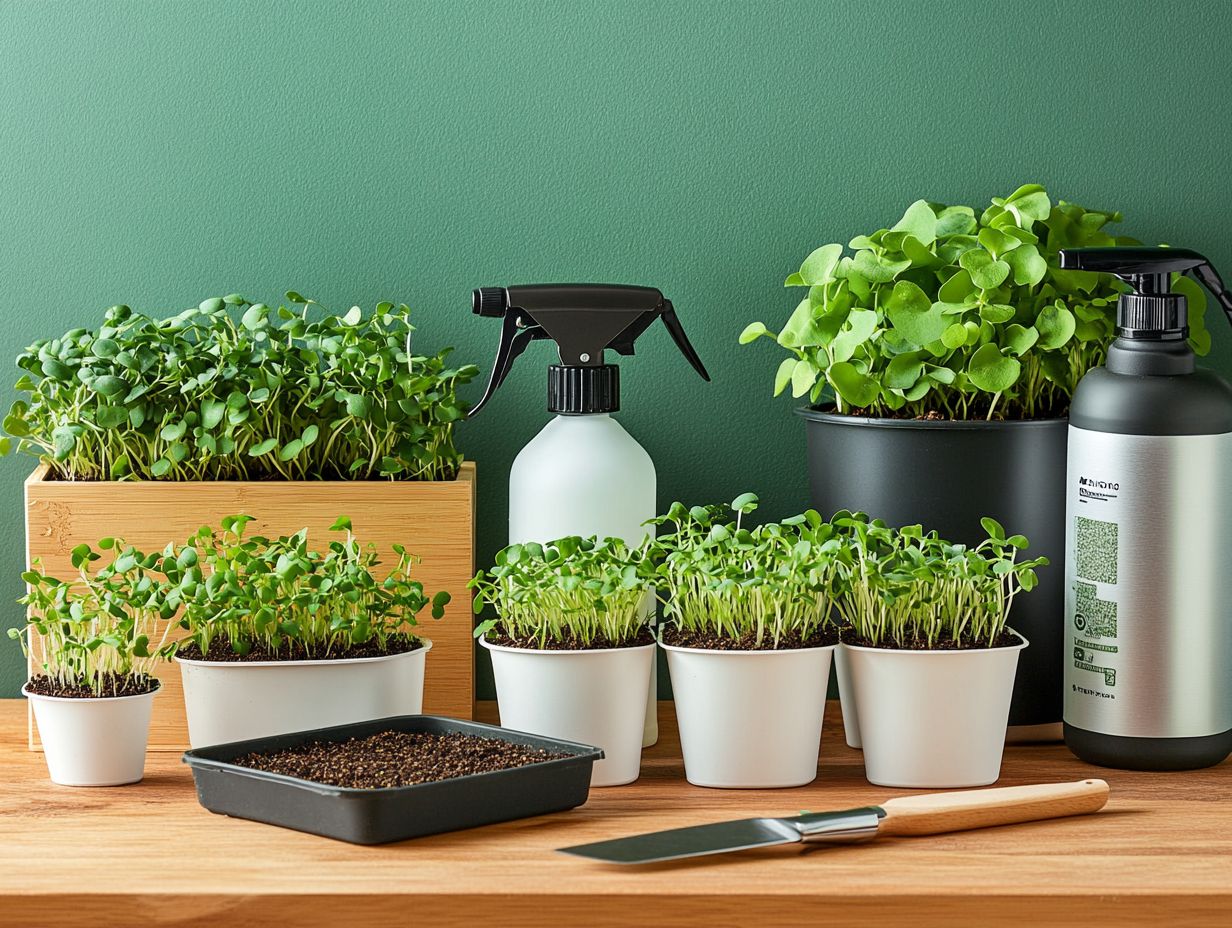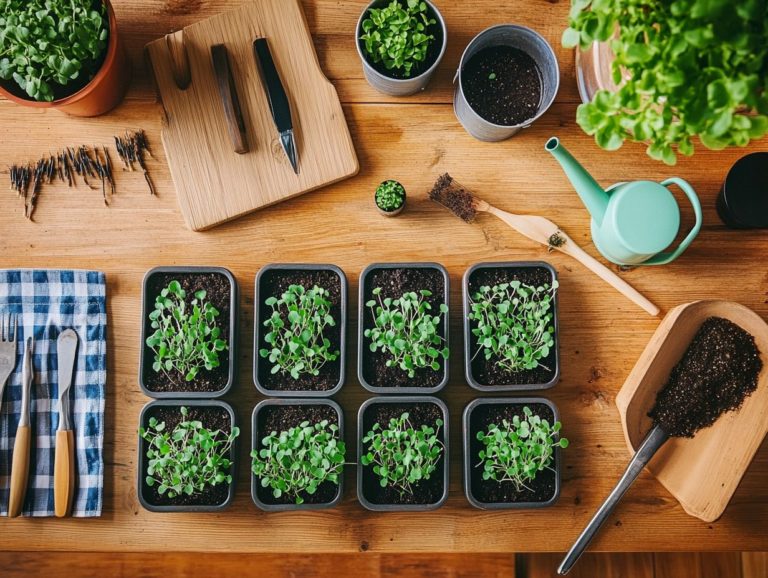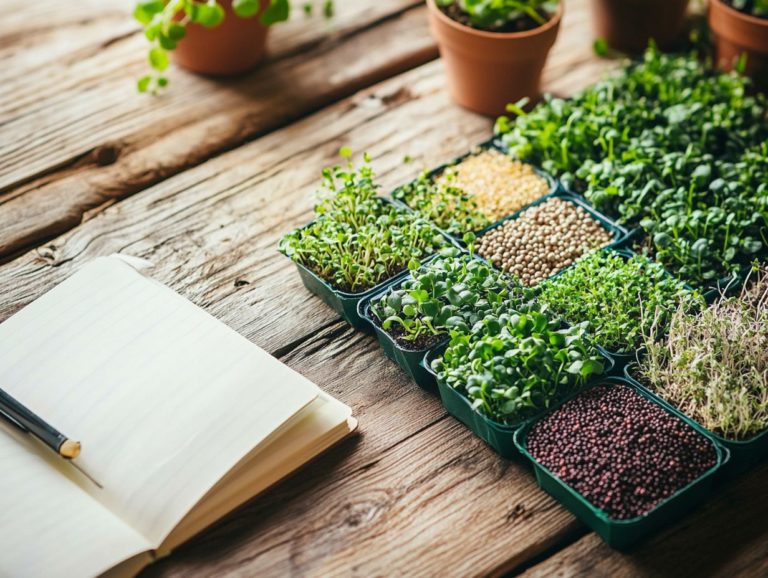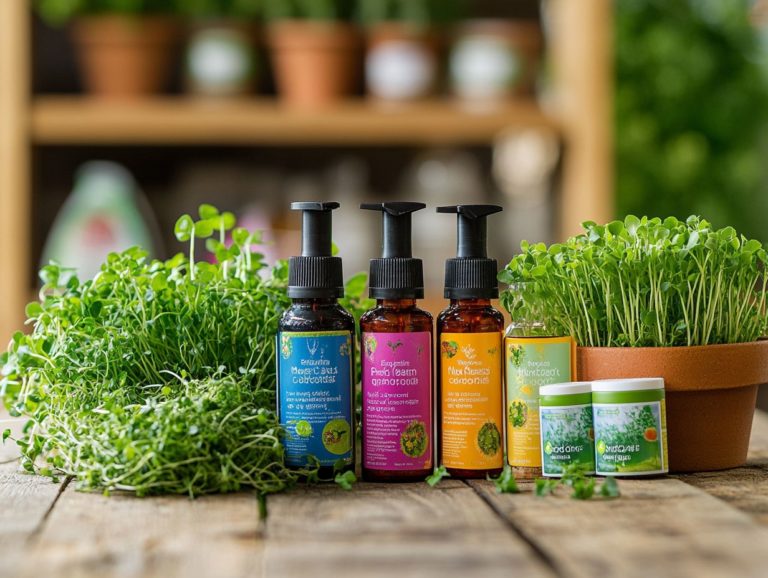Essential Maintenance Supplies for Microgreens
Microgreens are small but powerful plants. They deliver impressive flavors and health benefits.
Dive into the world of microgreens. Discover the various types and see why they’re a great addition to your garden.
This comprehensive guide will provide you with all the essentials, from selecting the right seeds to creating an ideal growing environment. It also tackles common pests and diseases, ensuring your microgreens flourish.
Are you prepared to nurture your green thumb?
Contents
Key Takeaways:

- Microgreens are young, nutrient-dense plants that offer various health benefits and can save on grocery costs.
- Essential maintenance supplies for growing microgreens include tools, materials, and the right seed varieties.
- Proper care, such as watering, fertilizing, and controlling pests and diseases, is crucial for healthy microgreens.
What are Microgreens?
Microgreens are exquisite young edible plants you harvest just after the first true leaves appear. Often lauded for their bold flavors, vibrant hues, and remarkable nutritional profiles, these tiny greens are a great addition to meals.
You can cultivate them from a diverse array of seeds, including sunflower, radish, and beet. Their rapid growth and minimal space requirements make them increasingly popular among home and urban gardeners alike.
Beyond their deliciousness, microgreens are packed with essential nutrients, elevating your meals while enhancing your overall health.
Definition and Types of Microgreens
Microgreens encompass a vibrant collection of young plants, featuring a variety of seeds like arugula, basil, and broccoli, each bringing its own distinct flavors and nutrient profiles to your culinary creations.
These delicate seedlings can enhance any dish. For example, radish microgreens offer a delightful peppery punch that complements salads and sandwiches beautifully, while sweet basil greens introduce a fragrant essence to Italian favorites.
If you’re considering growing your own, it s crucial to know that these petite greens flourish in bright light, thriving in well-drained soil with consistent moisture.
The conditions in which you grow them can greatly affect how quickly the seeds sprout. Certain varieties, such as sunflower microgreens, provide quicker results, while others may require a bit more time to reach maturity.
The choice of seeds and the timing of your harvest will also influence the overall nutritional density of these delectable greens, meaning how many vitamins and minerals they have compared to their size, making them a captivating addition to any culinary repertoire you wish to explore.
Benefits of Growing Microgreens and Indoor Gardening
Growing microgreens presents an array of benefits that extend from heightened nutritional values to noteworthy cost savings for both home and urban gardeners. These petite plants are brimming with essential vitamins and minerals think vitamin C, vitamin K, iron, and magnesium making them an exceptional addition to your diet.
Cultivating microgreens can become a fun and rewarding hobby, allowing you to savor fresh vegetables straight from your own home garden.
Nutritional Benefits and Cost Savings
Microgreens are truly a treasure trove of nutritional benefits, often boasting higher concentrations of essential minerals and vitamins compared to their fully grown counterparts.
Take varieties like sunflower and radish microgreens, for example; they re loaded with vitamins C, E, and K, along with a wealth of antioxidants that can bolster your overall health. This remarkable nutritional density makes them an irresistible choice for anyone seeking to elevate their diet without the bulk of traditional vegetables.
Growing microgreens at home isn t just a fun endeavor; it can also lead to substantial savings. A single packet of seeds can yield multiple harvests, cutting down on those annoying grocery trips. Plus, having fresh greens at your fingertips adds convenience and allows you to effortlessly infuse your meals with vibrant flavors and extra nutrients.
Ready to boost your meals with fresh greens? Let’s explore the amazing world of microgreens together!
Start growing your own microgreens today and enjoy the wonders of fresh flavors and benefits!
Supplies Needed for Growing Microgreens

To successfully cultivate microgreens, you’ll need essential tools and materials. These create an optimal environment for your nutrient-packed greens. Begin with suitable planting trays, a high-quality growing medium, and effective watering methods to maintain proper hydration during the time when seeds start to sprout.
Incorporating additional items, such as a kitchen scale for precisely measuring seed distribution and a reliable watering can for daily upkeep, will significantly enhance your microgreen-growing experience.
Essential Tools and Materials
Essential tools and materials for growing microgreens include a collection of items that elevate your gardening experience. You’ll want a watering can for efficient hydration and a kitchen scale for precise measurements.
Various specialized tools can enhance your cultivation process. For example, measuring cups are essential for accurately adding nutrient solutions. Sharp knives are vital for harvesting those delicate greens at just the right moment. Climate gauges are crucial for monitoring temperature and humidity levels, ensuring your microgreens thrive in optimal conditions. Additionally, you can refer to essential tips for growing microgreens at home for more insights on maximizing your gardening success.
Each of these tools not only streamlines your growing process but also contributes to healthier, tastier yields, aligning perfectly with your goal of sustainable microgreen production.
Choosing the Right Seeds for Microgreens
Choosing the right seeds is essential for cultivating successful microgreens. Each variety brings its own unique flavors, colors, and nutritional benefits, enriching both the aesthetic appeal and health advantages of your home garden.
When selecting seeds, it’s important to consider factors such as germination time and growth requirements. Some microgreen varieties flourish in specific environments. Additionally, knowing how to prevent spoilage in microgreens can help ensure that your garden not only looks vibrant but also thrives with the best possible yields.
Factors to Consider and Recommended Varieties
When choosing seeds for your microgreens, you ll want to consider key factors like germination time, flavor, and nutrient density. Varieties such as radish, sunflower, and pea shoots often emerge as top contenders.
These elements are vital for achieving a successful harvest that delights the palate while delivering a wealth of nutrients. Take radish microgreens, for example they germinate in just 5 to 10 days and add a peppery kick to your salads and sandwiches, boosting both taste and vitamin content.
Sunflower microgreens are another fantastic option, sprouting quickly and offering a delightful nutty flavor that adds a satisfying crunch to your dishes. As for pea shoots, they take about 7 to 14 days to germinate, bringing a sweet, fresh taste that complements a variety of cuisines, making them perfect for stir-fries and salads.
Grasping these factors can greatly influence the success of your microgreen garden, providing not just nourishment but also an explosion of flavor and health benefits.
Preparing the Growing Environment
Creating the perfect growing environment is crucial for your thriving microgreens. This involves meticulous management of light, temperature, air circulation, and photosynthesis.
During the germination phase, your microgreens will flourish in darkness, as this blackout period encourages seed sprouting. Once they ve sprouted, introducing light will promote healthy photosynthesis and robust growth.
Additionally, ensuring proper air circulation and maintaining the right temperature will not only strengthen your plants but also help you sidestep potential issues down the line.
Caring for Microgreens
Caring for microgreens requires your dedicated attention and a touch of finesse. You’ll want to engage in regular daily maintenance and use careful watering methods, including misting water. Adhering to timely harvesting tips will unlock the best flavors and nutrient levels in these delicate greens.
By grasping the essentials of nutrient provision and creating optimal growing conditions, you can significantly enhance both the growth and quality of your microgreens. Additionally, knowing the best methods for storing microgreens will help maintain their freshness.
Watering, Fertilizing, and Harvesting Tips
Watering, fertilizing, and harvesting are essential elements in taking care of microgreens. Adopting a thoughtful approach will help you maintain optimal nutrient levels for the finest culinary outcomes, especially when using microgreen seeds.
Consider employing effective watering techniques to significantly enhance growth and overall health. Misting water onto the seedlings can create a humid microclimate, fostering vigorous development during the germination process.
Utilizing watering trays allows you to manage moisture levels with finesse. They efficiently drain excess water, thus preventing root rot, which is when roots decay due to excess moisture.
Regarding fertilizing, opt for a thinned-out liquid fertilizer rich in essential nutrients. Applying it sparingly ensures your plants receive just the right amount without being overwhelmed.
For the tastiest microgreens, timing your harvest is key. Being mindful of when to harvest microgreens ensures that they re bursting with taste, making them a delightful addition to any dish.
Common Pests and Diseases in Microgreens
Just as with any other plant, microgreens can fall prey to various pests and diseases that threaten their growth and quality. Recognizing these common challenges and employing effective prevention and treatment strategies is essential for nurturing a thriving microgreens garden.
Paying attention to these details will ensure your garden thrives beautifully!
Prevention and Treatment Measures
Prevention and treatment measures are crucial for safeguarding your microgreens against common pests and diseases, ensuring they grow robustly and yield high-quality harvests.
To effectively keep those unwanted insects and pathogens at bay, you should embrace a multi-faceted approach. This means maintaining impeccable sanitation practices by regularly cleaning your tools and surfaces, which significantly reduces the risk of contamination.
Enhancing air circulation in your growing environments is another key strategy. It helps lower humidity levels that can foster disease. Implementing environmental controls like temperature regulation and diligently monitoring moisture levels also plays an essential role in preventing problems before they arise.
When pests do make an appearance, consider using organic solutions such as neem oil or insecticidal soaps. These treatments are effective and align perfectly with sustainable practices. By understanding and applying these strategies, you empower yourself to maximize your yields while ensuring the health of your crops.
Stay vigilant and proactive to keep your microgreens thriving!
Frequently Asked Questions

What are essential maintenance supplies for microgreen farming?
You need several supplies for microgreen farming. These include growing medium, planting trays, seeds, water, and a light source.
Why do I need potting soil for my microgreens?
Potting soil gives microgreens the nutrients they need. It also retains moisture for healthy roots.
Do I need specific trays for growing microgreens?
Yes, use trays designed for microgreens. They ensure proper drainage and ventilation.
What kind of seeds should I use for microgreens?
Use seeds labeled as microgreen or sprouting . These seeds are smaller and perfect for growing microgreens.
How often should I water my microgreens?
Water microgreens once or twice daily. Keep the soil moist, but avoid overwatering.
Can I use any light source for my microgreens?
Natural sunlight is ideal for microgreens. If that s not possible, use grow lights and adjust their distance and timing according to your plants needs.






